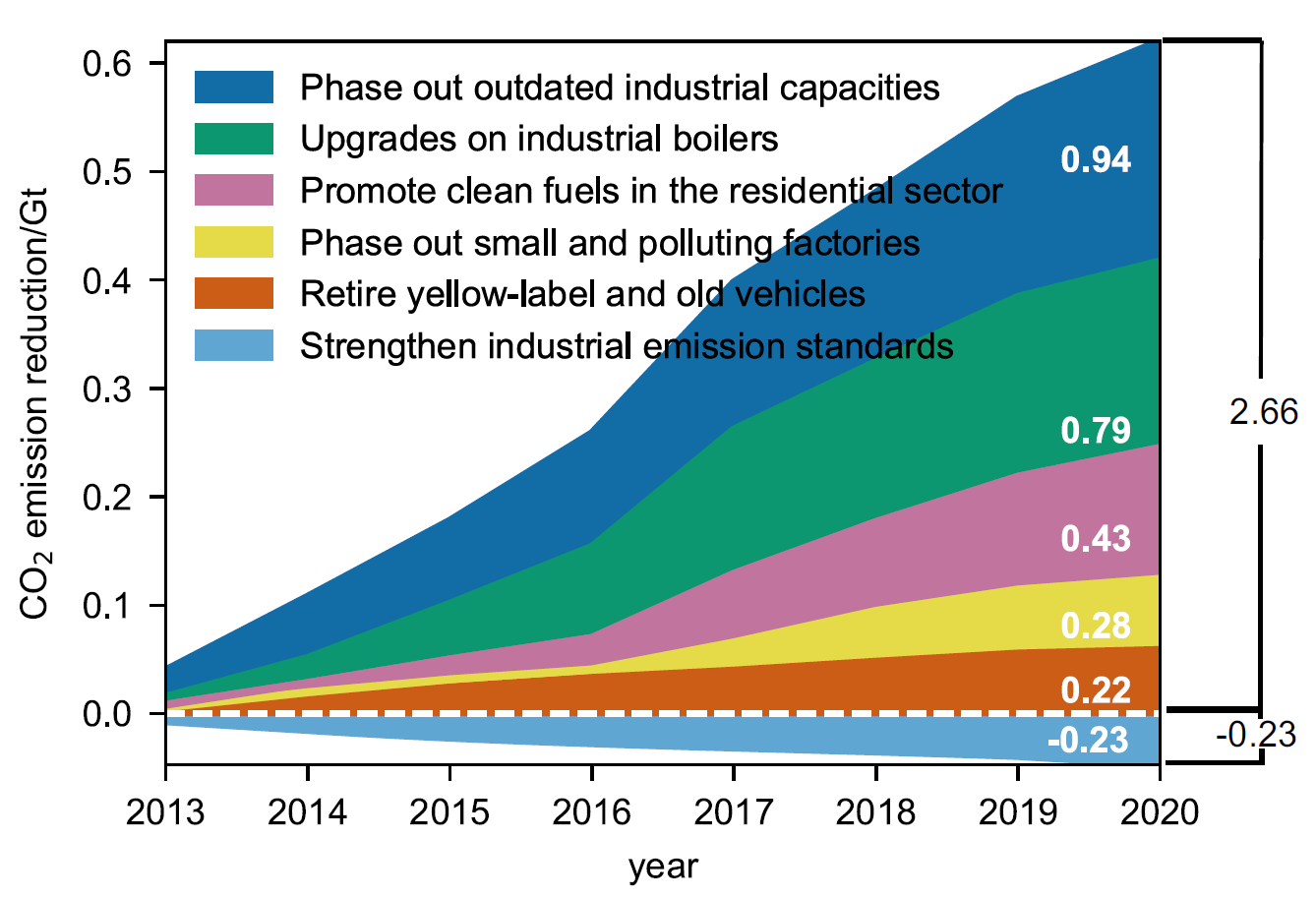A consensus has been reached that measures coping with climate change can effectively improve air quality, and air pollutants and greenhouse gases share the same sources. The clean air measures implemented in China in the recent years have substantially reduced air pollutants and their impact on climate change has also drawn widespread attention. The related research on the impact of clean air actions on climate change is mainly concerned with climatic factors such as radiation feedback change caused by air pollution. Only a very small amount of research has estimated the co-benefits of CO2 emission reduction brought about by the implementation of clean air actions in key areas. No research has quantified the co-benefits of CO2 emission reduction nationwide contributed by China’s clean air actions since the implementation of the Air Pollution Prevention and Control Action Plan in 2013, or conducted in-depth analysis from the perspective of measures.
Addressing the above problem, Zhang Qiang’s Research Group of the Department of Earth System Science (DESS), Tsinghua University reviewed the five major clean air measures which may also lead to co-reductions on CO2 emissions, i.e., phasing out outdated industrial capacity, upgrades on industrial boilers, promoting clean fuels in the residential sector, phasing out small and polluting factories, and retiring yellow label and old vehicles. On the basis of the independently developed model of the Multi-resolution Emission Inventory of China (MEIC), measure-specific co-reduction effect assessment technology was developed. Meanwhile, the changes in energy supply and consumption structure induced by various co-reduction measures were quantified according to the actual implementation of the measures across provinces. Finally the co-benefits of CO2 emission reduction from China’s clean air actions were estimated. The findings have been recently published in Nature Communications as an article titled “Co-benefits of CO2 emission reduction from China’s clean air actions during 2013-2020”.
The research shows that China’s clean air actions involve related measures to control the total energy consumption, adjust the energy structure and improve the energy efficiency. The phasing out or upgrades of backward combustion facilities with low energy efficiency and high pollution has promoted the transformation of China's energy system, reduced the consumption of fossil fuels, and produced significant co-benefits of CO2 emission reduction. From 2013 to 2020, the co-benefits of CO2 emission reduction induced by the implementation of clean air action measures in China far exceeded the additional CO2 emission caused by the installation of end-of-pipe control equipment, and the net cumulative emission reduction reached 2.43 3 billion tons, surpassing the accumulated CO2 emission increases in China (2.03 Gt CO2), resulting in considerable climate benefits.
It is pointed out in the research that the China’s clean air actions have promoted the replacement of inefficient and high-carbon energy facilities by clean and efficient energy facilities, and accelerated energy performance improvement, energy structure transformation and industrial structure transformation. Through the implementation of clean air actions, from 2013 to 2020, a total of 1.06 billion tons of standard coal was saved and 2.43 billion tons of CO2 emission was reduced, accounting for 3.1% of the total carbon emissions in China. Among them, in 2020, 247 million tons of standard coal will be saved and 570 million tons of carbon dioxide will be reduced, accounting for 5.5% of the country's total carbon emissions during the period. This experience of co-reductions also offers a possible transition alternative to low-carbon development path for developing countries plagued by air pollution problems. In the future, China should still further optimize its energy system and economic structure to promote the realization of the goals of carbon peaking and carbon neutrality, and the design of emission reduction policies should focus on the relevant measures with significant co-benefits of CO2 emission reduction.
Shi Qinren, a Ph.D. student of Tsinghua University School of Environment, and Zheng Bo, Assistant Professor of Shenzhen International Graduate School, Tsinghua University, are the co-first-authors of the article, and Professor Zhang Qiang from the DESS, Tsinghua University, is the corresponding author of the article. Many experts and scholars from the Environmental Planning Institute of the Ministry of Ecology and Environment, the DESS and the School of Environment of Tsinghua University have participated in the research. The research is supported by the National Natural Science Foundation and the Energy Foundation of China.
Full-text link: https://www.nature.com/articles/s41467-022-32656-8

Figure: Accumulated CO2 emission reduction between 2013 and 2020 by each of the five co-beneficial measure in China’s clean air actions
.